C9754
Colchicine
≥95% (HPLC), powder, antimitotic agent
Synonym(s):
(S)-N-(5,6,7,9-Tetrahydro-1,2,3,10-tetramethoxy-9-oxobenzo[a]heptalen-7-yl)acetamide
About This Item
Recommended Products
product name
Colchicine, ≥95% (HPLC), powder
Assay
≥95% (HPLC)
form
powder
color
white to yellow
mp
150-160 °C (dec.) (lit.)
solubility
ethanol: 50 mg/mL
SMILES string
COC1=CC=C2C(=CC1=O)[C@H](CCc3cc(OC)c(OC)c(OC)c23)NC(C)=O
InChI
1S/C22H25NO6/c1-12(24)23-16-8-6-13-10-19(27-3)21(28-4)22(29-5)20(13)14-7-9-18(26-2)17(25)11-15(14)16/h7,9-11,16H,6,8H2,1-5H3,(H,23,24)/t16-/m0/s1
InChI key
IAKHMKGGTNLKSZ-INIZCTEOSA-N
Gene Information
human ... ABCB1(5243) , CYP3A4(1576) , TUBA1A(7846) , TUBA1B(10376) , TUBA1C(84790) , TUBA3C(7278) , TUBA3E(112714) , TUBA4A(7277) , TUBB(203068) , TUBB1(81027) , TUBB2A(7280) , TUBB2B(347733) , TUBB3(10381) , TUBB4A(10382) , TUBB4B(10383) , TUBB6(84617) , TUBB8(347688)
mouse ... Abcb1a(18671) , Abcb1b(18669)
Looking for similar products? Visit Product Comparison Guide
General description
Application
- in the in vitro sister-chromatid exchange (SCE) assay
- to study its in vitro antiviral, antibacterial, antifungal and cytotoxic activities
- in microtubule disruption
- to analyse its effects on Ca2+ transients from taxol-treated cells
Biochem/physiol Actions
Features and Benefits
Storage and Stability
Signal Word
Danger
Hazard Statements
Precautionary Statements
Hazard Classifications
Acute Tox. 2 Oral - Muta. 1B
Storage Class Code
6.1A - Combustible acute toxic Cat. 1 and 2 / very toxic hazardous materials
WGK
WGK 3
Flash Point(F)
Not applicable
Flash Point(C)
Not applicable
Personal Protective Equipment
Certificates of Analysis (COA)
Search for Certificates of Analysis (COA) by entering the products Lot/Batch Number. Lot and Batch Numbers can be found on a product’s label following the words ‘Lot’ or ‘Batch’.
Already Own This Product?
Find documentation for the products that you have recently purchased in the Document Library.
Customers Also Viewed
Articles
Discover Bioactive Small Molecules for ADME/Tox
Discover Bioactive Small Molecules for ADME/Tox
Discover Bioactive Small Molecules for ADME/Tox
Discover Bioactive Small Molecules for ADME/Tox
Our team of scientists has experience in all areas of research including Life Science, Material Science, Chemical Synthesis, Chromatography, Analytical and many others.
Contact Technical Service














